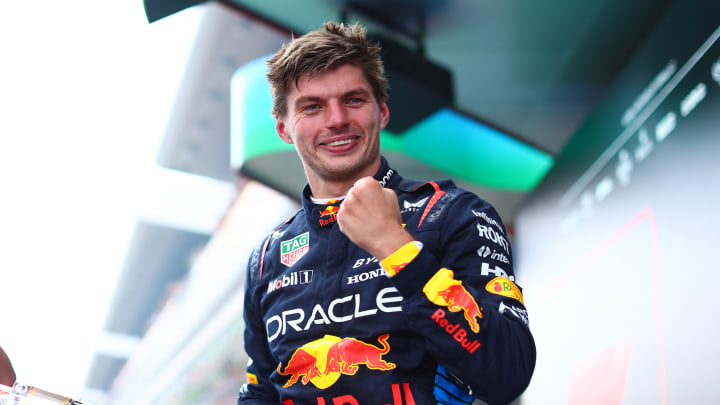Spanish Grand Prix Takeaways: Max Verstappen Staves Off McLaren's Gamble

For the first time in more than two months, Max Verstappen converted on a second consecutive race, holding off a charging Lando Norris to win the 2024 Spanish Grand Prix. The Red Bull star started second on the grid behind the McLaren, but quickly reclaimed the lead on the third lap after a sensational start from George Russell and never relinquished his advantage as he claimed his third straight victory in Barcelona.
Norris settled for second after opting for a race strategy that was slightly different from the other lead drivers following a lackluster start. Lewis Hamilton, who began in third, maintained his position to round out the podium—his first finish in the top-three since last year’s Mexican Grand Prix.
Here’s what to know from Sunday’s Spanish Grand Prix:
McLaren’s Strategy Doesn’t Pay Off
To beat out the seemingly inevitable Verstappen, McLaren had to gamble when it came to pit-stop strategy. Though Norris actually did grab the upper hand strategically, it wasn’t enough to storm back and overtake the Red Bull by race’s end.
While Verstappen came in for his first pit stop of the afternoon around lap 17, McLaren opted to keep both of their drivers out beyond lap 20, with Norris not coming in until lap 23. The move sacrificed track position but gave the 24-year-old fresher tires than the Red Bull team’s after each of the day’s two pit stops, allowing him to be the hunter rather than the hunted.
Half a lap, wheel to wheel 😱
— Formula 1 (@F1) June 23, 2024
Box office entertainment from Lando and George! 🍿#F1 #SpanishGP pic.twitter.com/waADJJL1fV
Norris cut into Verstappen’s lead during the stints immediately after each stop, but the three-time world champion didn’t make any pivotal mistakes and was able to hold on to win by 2.2 seconds. Afterwards, both drivers admitted that the McLaren appeared to be the superior car on the day, but that a slightly stunted start didn’t give Norris the position to make a better move later on. Even so, Norris leaped Charles Leclerc to take over second in the drivers’ standings through 10 races.
Verstappen has now won seven races on the year and three of the last five, but his recent victories haven’t been sure bets. It’s a testament to his performance as a driver when each of the last three wins (in Imola, Montreal and now Barcelona) have come when he doesn’t seem to have the best car on Sunday.
Ferrari Fading While Mercedes Makes Gains
Right after Verstappen and Norris came the duos of Mercedes and Ferrari. Hamilton and Russell claimed third and fourth, while Leclerc and Carlos Sainz settled for fifth and sixth. Those finishes could be an indication of a power shift in the chase pack behind Red Bull as Mercedes capped off another strong weekend while Ferrari left somewhat disappointed yet again.
As for the former, Hamilton put together his best three-day stint of the season in Barcelona, converting a third-place qualifying finish on Sunday with a comfortable, hard-earned spot on the podium. The seven-time world champion had his fair share of battles with Sainz out on the track but showed flashes of his elite form en route to a second straight top-four finish. Russell, ultimately unhappy with his last stint on hard tires, finished fourth after an electric start, but was able to keep out a probing Leclerc on the last lap.
Though it would have been difficult to come away any worse than Canada’s double DNF, Ferrari leaves Spain unsatisfied. Leclerc and Sainz were off the pace all weekend—a foreboding sign for holding onto second in the constructors championship, much less chasing down Red Bull at the top. Ferrari still holds a 33-point advantage over McLaren but has relinquished 35 points over the last two races. For the team that had the most consistent start to the year, the rest of the current tripleheader will be pivotal for rediscovering form ahead of the summer break, or else the group risks a repeat of last year’s midseason slide.
Alpine’s Ascension
Only five teams scored Sunday in a race that didn’t feature a single safety car or red flag, or a significant number of overtakes. Alpine was the best of the rest in Spain, following through on another great weekend of qualifying to nab double points for a second consecutive race.
Though progress may appear slow, Alpine’s step forward is evident. Esteban Ocon and Pierre Gasly had only amassed one point through their first seven races but have racked up seven points in the last three outings, surpassing Williams and Haas to settle into seventh in the conductor standings. The two teammates, despite a handful of tense moments between them on the track this season (highlighted by contact with one another in Monaco), have been among the most balanced team duos this season, and that’s been a factor in their recent improvement.
Sure, Alpine is unlikely to compete for a race win, or even a podium in 2024. However, those jumps up the conductor standings are pivotal for end-of-year earnings, and the difference between, say, a sixth- or seventh-place finish is sizable.
Next up in Alpine’s sights is RB, which went scoreless for the first time in five races Sunday. Gasly and Ocon will look to pull in Yuki Tsunoda and Daniel Ricciardo beginning next weekend at the Austrian Grand Prix.
